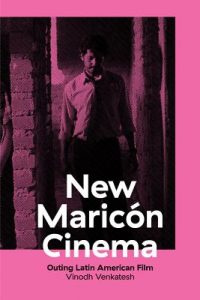 New Maricón Cinema: Outing Latin American Film
New Maricón Cinema: Outing Latin American Film
by Vinodh Venkatesh
University of Texas Press. 252 pages, $29.95
I STILL REMEMBER the first time I saw Alfonso Cuarón’s Y Tu Mamá También, in a small independent theater in Princeton, New Jersey in 2001. The film, about two teenage boys (played by Diego Luna and Gael García Bernal, then relative unknowns) and Luisa, a somewhat mysterious older woman (Maribel Verdú), had already garnered much buzz for its fresh and sexy edginess. Even so, the audience let out a collective gasp during the penultimate scene, when Tenoch and Julio—who up to that point appear as typical heterosexual adolescents with raging hormones—start making out with each other, while being fellated by Luisa. The post-film conversation with my partner (now husband) centered on the obvious questions: were the boys really gay? bisexual? Or were they just really drunk? There seemed to be no satisfactory answer.
As Vinodh Venkatesh explains in New Maricón Cinema: Outing Latin American Film, such sexual ambiguity in Cuarón’s film is quite deliberate. Moreover, this ambiguity is not merely a matter of narrative—Diego and Tenoch never talk about the kiss—but an effect of Cuarón’s cinematographic techniques. The audience never actually sees what Luisa is doing, since the camera focuses only on the facial expressions of the two boys. The viewer, “disoriented by the sucking and licking mouth of Luisa off camera and the naked, drunken heat of the two friends,” is moved from a position of spectatorship to one that is more participatory and sensuous. Put simply, we don’t see the event so much as we experience it: “we share saliva and caress the tongues and lips of Julio and Tenoch … as (homo)erotically involved and complicit subjects.” From this perspective, questions about who is and isn’t gay quickly become complicated.
For Venkatesh, Y Tu Mamá También is not significant primarily because it helped put Mexican filmmaking on the global map or because it launched the careers of Cuarón, Luna, and García Bernal (though it did do these things), but because it anticipated a wave of films that Venkatesh categorizes as “New Maricón.” (“Maricón” is a Spanish slang term that’s roughly equivalent to “queer” or “fag.”) These are gay- or queer-themed films that Venkatesh distinguishes from earlier Maricón films, which, even when representing gay characters sympathetically, tend to reinforce ideas about homosexuality as different or deviant. New Maricón films, by contrast, collapse the “safe” distance between their audiences and their queer characters, and in the process they unsettle conventional ideas about sexual types or identities.
At times Venkatesh’s categorization of Maricón and New Maricón cinema comes across as a distinction between “gay” and “queer” films. To an extent this analogy holds true. Yet Venkatesh is tracing something beyond questions of sexual or gender identities. New Maricón films, as he describes them, fundamentally alter the conventional relationship between a film’s viewers and its characters. Part of this change happens through a relocation of queer space, or “deterritorialization.” For example, many New Maricón films take place outside of the urban centers where gayness is legible and safely contained. More profoundly, these films make possible a greater empathetic relationship between viewer and subject by enabling the viewer to share the subject’s aural and tactile experiences rather than merely look from a distance—what Venkatesh identifies as the “traditional scopophilic nature” of gay-themed cinema.
Readers who are not immersed in critical theory may wonder what exactly Venkatesh means by this. How can a viewer “feel” a film? Fortunately, Venkatesh’s close and detailed analyses of particular scenes help to convey the kind of cinematic experience he is postulating. For example, in a chapter on Javier Fuentes-León’s Contracorriente (Undertow), a film that dominated the LGBT film festival circuit in 2010, he deconstructs a lovemaking scene between Santiago and Miguel, the film’s main characters, pointing out how the viewer never sees either body as a “complete whole.” This cinematic technique of showing the body only in “bits and pieces” prompts the viewer to inhabit imaginatively the sensory experience of the film’s characters. For Venkatesh, it is this “affective” cinematic experience that defines New Maricón cinema more than anything else.
As with the Cuarón and Fuentes-León films, New Maricón Cinema is most enjoyable as a companion to the films themselves, and as a goad to see these films in the first place. (Many are available on DVD or from streaming sites, with English subtitles.) The one drawback is likely to be the book’s language, which is often jargon-heavy (even for a film study) and unnecessarily arcane. This is a pity, since Venkatesh’s subject and argument should appeal to a much wider audience than film scholars. Still, those looking to expand their repertoire of Latin American gay-themed films, or deepen their appreciation of these films, would do well to consult this book.
________________________________________________________
Joseph M. Ortiz is associate professor of English at U-Texas, El Paso.





